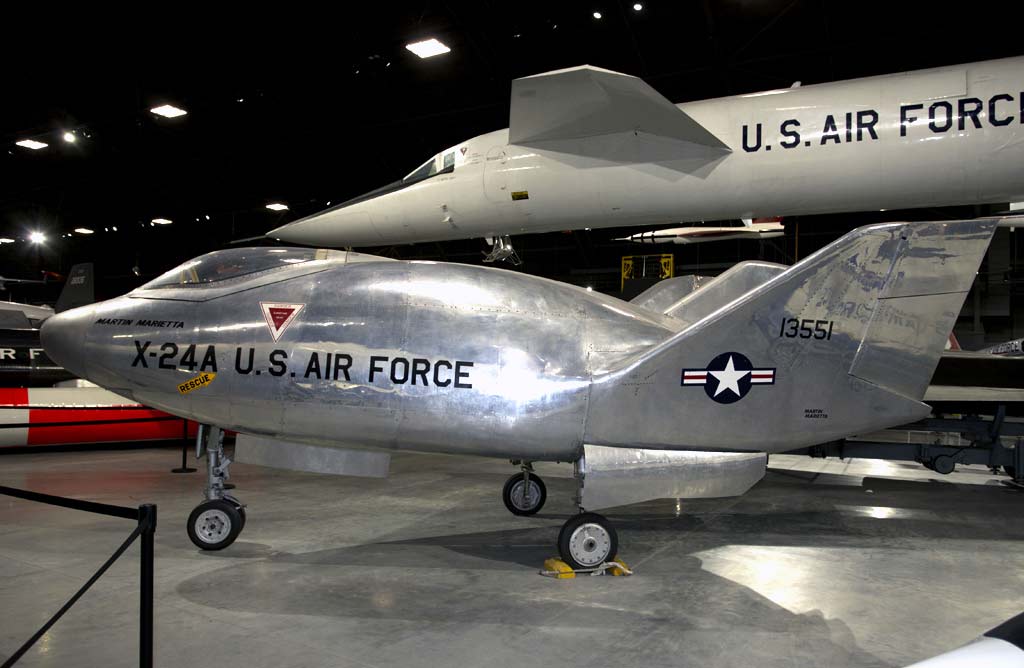The Martin X-24B is an experimental lifting body aircraft designed for NASA’s research on space re-entry.
In brief
The Martin X-24B represents a pivotal experiment in the exploration of lifting body theories, which are crucial for spacecraft design and re-entry. Developed in the 1960s as part of a collaborative effort between NASA and the US Air Force, this aircraft served as a testbed for understanding how vehicles could be controlled during atmospheric re-entry from space. Unlike conventional aircraft, the X-24B lacks wings and generates lift through its body shape, a concept that significantly influences modern spacecraft design. The X-24B’s design facilitated valuable data collection on heat resistance, lift, and maneuverability in high-altitude and high-speed conditions. It paved the way for the development of the Space Shuttle and other re-entry vehicles by demonstrating controlled glide and landing capabilities crucial for future space missions.
The Martin X-24B experimental aircraft
The era of the 1960s and 1970s was marked by rapid advancements in space exploration and aircraft technology. Amid the space race and increasing interest in developing reusable spacecraft, the Martin X-24B emerged as a critical experiment. The need for an aircraft that could provide insights into controlled re-entry from space led to the development of the X-24B. This experimental aircraft aimed to validate the concept of lifting bodies, which could offer a viable solution for spacecraft to return to Earth safely and land like an airplane.
The X-24B program was launched by NASA and the US Air Force in the mid-1960s, building on the research from earlier lifting body designs. The first flight of the X-24B took place on August 1, 1973. Unlike traditional aircraft, it did not have a specific NATO nickname due to its unique role and experimental status. The program sought to fill the gap in knowledge regarding atmospheric re-entry dynamics, a challenge for space missions returning to Earth.
Design
The Martin X-24B’s design is a testament to innovative aerospace engineering. With its length of 37.5 feet (11.4 meters) and a maximum width of 19.8 feet (6.0 meters), the X-24B’s shape was optimized to generate lift without conventional wings. This lifting body concept, where the vehicle’s fuselage produces necessary lift, was revolutionary. The X-24B featured a flat bottom and rounded top, with fins and rudders for stability and control. This design allowed for the validation of flight characteristics needed for re-entry vehicles, such as managing heat buildup and achieving controlled descent and landing.
One of the primary advantages of the X-24B’s design was its potential to significantly influence the development of future spacecraft, including the Space Shuttle. However, the drawbacks included challenges in achieving stable flight at lower speeds and the complexity of landing without traditional wing-generated lift.

Performance
The X-24B was propelled by a rocket engine capable of providing a short burst of high thrust. This engine allowed the X-24B to reach speeds up to Mach 1.6 and altitudes beyond 70,000 feet (21,336 meters). The aircraft’s performance in high-speed, high-altitude flight conditions provided invaluable data on aerodynamic heating, lift-to-drag ratios, and the handling characteristics of lifting body vehicles.
Comparing the X-24B to contemporary experimental aircraft of its time, such as the North American X-15, it offered unique insights into low-speed control and landing of a lifting body, an area where traditional rocket-powered aircraft provided limited data. The X-24B’s achievements in demonstrating controlled glide and landing significantly contributed to the design and development of the Space Shuttle.
Variants
The Martin X-24B itself was an evolution of its predecessor, the X-24A. The X-24A featured a more pronounced, blunt body design, which was modified to the sleeker, more aerodynamic shape of the X-24B to improve its performance and handling characteristics. These modifications were based on the flight data and research outcomes from the X-24A flights, leading to enhanced aerodynamic efficiency and heat management capabilities in the X-24B.
Military Use and Combat
As an experimental aircraft focused on research into lifting body designs and re-entry physics, the Martin X-24B was not designed or used for military combat or operations. Its value lay in the extensive data it provided on aerodynamics, heat resistance, and flight control at high speeds and altitudes, informing the development of future spacecraft and military aircraft. The X-24B’s legacy is seen in the technologies it helped pioneer, which have been applied in various aerospace applications, including the Space Shuttle program and potentially reusable military space vehicles.
–
The Martin X-24B marks a significant milestone in aerospace research, providing critical data on lifting body concepts and the challenges of atmospheric re-entry. Its contributions go beyond the immediate results of its test flights, influencing the design and development of future spacecraft and aviation technologies. The X-24B’s legacy underscores the importance of experimental aircraft in advancing our understanding of flight physics and spacecraft design, paving the way for innovations in both military and civilian aerospace applications.
Back to the experimental aircraft section.